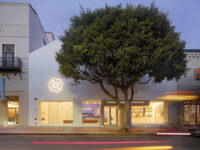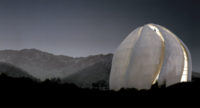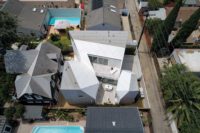When the Mexican hydroponics company Next Vegetales bought land adjacent to its greenhouse in rural Guanajuato state, the owner wanted to do more than expand its production capacity. He asked his friend Manuel Cervantes of CC Arquitectos in Mexico City to design an office that would, in Cervantes's words, 'improve the employees' quality of life and unite them in a shared sense of purpose.' The low-slung minimalist building he conceived skillfully weaves together indoor and outdoor spaces to offer a collaborative, relaxed atmosphere within a cutting-edge agricultural operation.
For security reasons, the complex is not open to the public. Turning off the main street in the town of San Francisco del Rincón, you navigate cobblestone and dirt roads to a parking lot with a gated checkpoint. From there, you walk down a paved access road past one greenhouse to the office's entry path, an assemblage of stone tiles, wooden railroad ties, and rustic stone walls. It's a reminder of the bumpy roads you took to get here.
From this vantage point, Cervantes's 13,500-square-foot, stucco-clad concrete building seems nearly as monolithic and impenetrable as the greenhouses that flank it. In a public location, this effect might be off-putting, but here it mitigates the differences in scale among the structures so that the office doesn't seem dwarfed by its enormous neighbors. And the white stucco harmonizes with the gray aluminum-and-polyethylene facades of the greenhouses, linking the three visually.
Once inside the low-key building, you see that the floor plan reveals a much different character. Past the entry, you encounter a series of interconnected volumes housing various functions: conference and meeting rooms, training areas, workstations. They all spill into a breezy, semi-enclosed central courtyard, which serves as an informal gathering spot and a backup workspace with casual seating and Wi-Fi access. The hefty concrete roof slab hovers over it all, linking these airy spaces. You feel not so much indoors as tucked into the surrounding landscape, and natural ventilation keeps temperatures bearable even on hot, humid days. Only the offices have central air-conditioning, and it's not used often, says Cervantes. The cooler, north-facing rooms don't have it at all.
Providing visual connections among coworkers and offering access to nature emerge as two key motifs. Walls of glass and white stucco allow for ample daylighting and framed outdoor views. There's not a partition or solid wall to be found between workstations or enclosing private offices, and a glass wall permits office workers to look directly into the newer greenhouse to the south, which features the latest hydroponics equipment. (Picture an indoor field of lettuces, grown in trays and stretching practically as far as the eye can see.) In addition to sharing the central courtyard, nearly every functional area opens onto a dedicated patio. A vibrant one adjacent to the workstations was designed by artist Jerónimo Hagerman and features hanging Cissus antartica vines with dark-green leaves that are adaptively changing hue because of the bright-yellow wall behind them.
Materials, many of them sourced locally, were chosen for their durability and neutral appearance. Cervantes manipulated them to define transitions—in short halls or passageways between volumes, for example, where the walls and ceiling are covered in the same smooth walnut used for doors and furniture in the conference rooms. Marble floor tiles are polished indoors but left unpolished on patios, in the courtyard, and on the entry walkway, a nod to the rugged nature of the outdoors and a feature that makes them less slippery when wet.
Following the lead of tech-company facilities, many office designs today try to encourage interaction and break down barriers between management and workers. Cervantes's project for Next accomplishes these goals while establishing a sense of calm and order, and underscoring the importance of the natural world to the business being conducted. For employees, it seems to have hit the right notes. As Arnulfo Canchola Caro, a maintenance supervisor, said on a recent visit, 'It's a pleasant place to be. Often when I'm here, I forget I'm at work.'
PeopleClient/Owner: Architect: Personnel in architect's firm who should receive special credit: Consultant(s): Lighting: cc arquitectos Other: Jeronimo Haggerman art installation General contractor: Segura Constructora Photographer(s): Rafael Gamo Size: 13,500 square feet Construction cost: $1.4 million Completion date: October 2014 |
ProductsStructural system Exterior cladding Roofing Windows Glazing Doors Interior finishes Paints and stains: Comex paint Wall coverings: masonry Floor and wall tile: local marble (santo tomas) Furnishings Reception furniture: CC arquitectos Chairs: Organitec Tables: CC arquitectos Lighting Exterior: Construlita |











Post a comment to this article
Report Abusive Comment